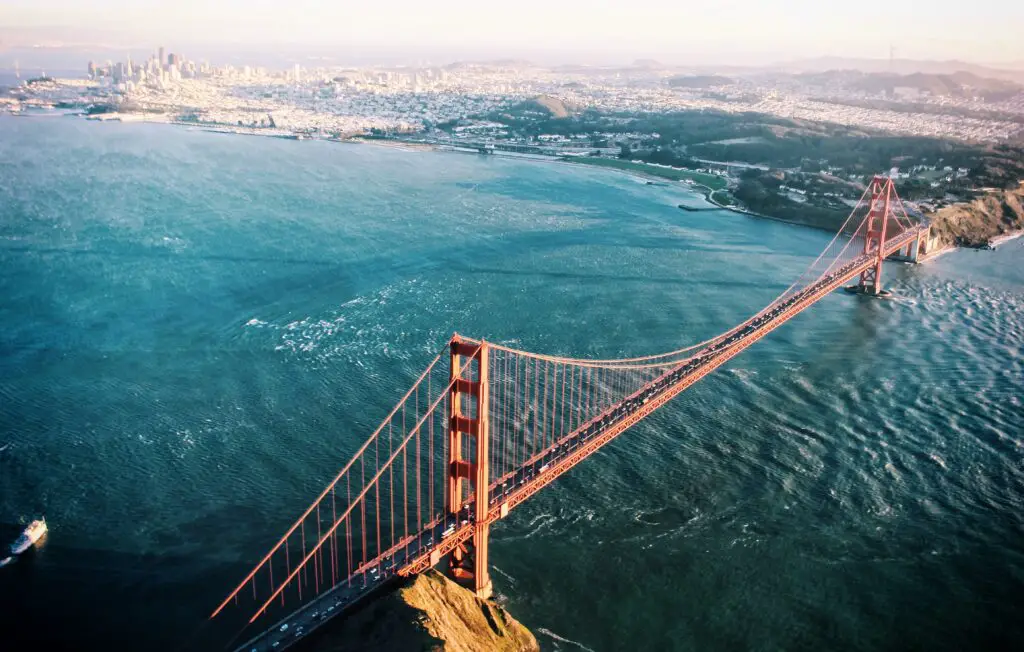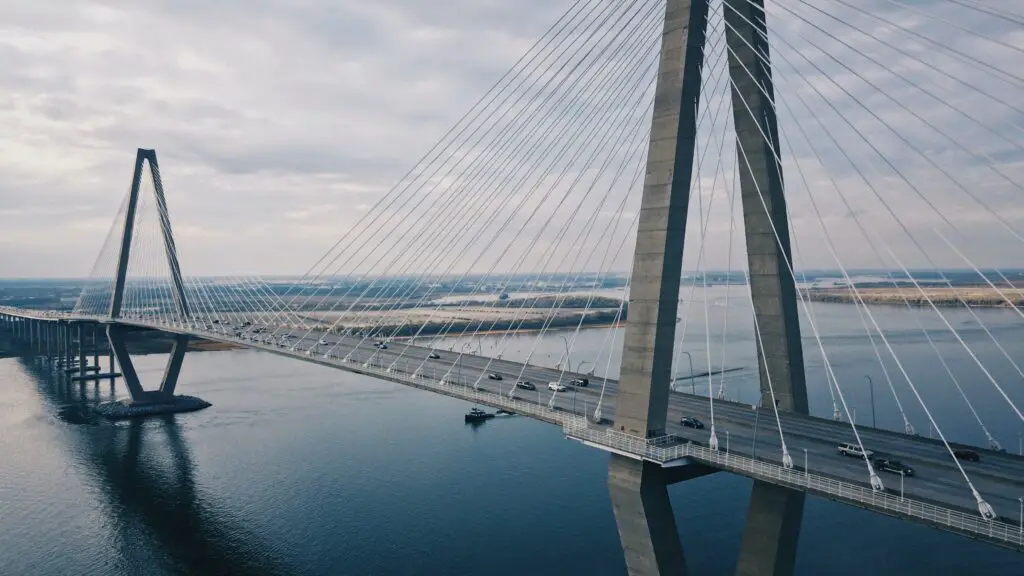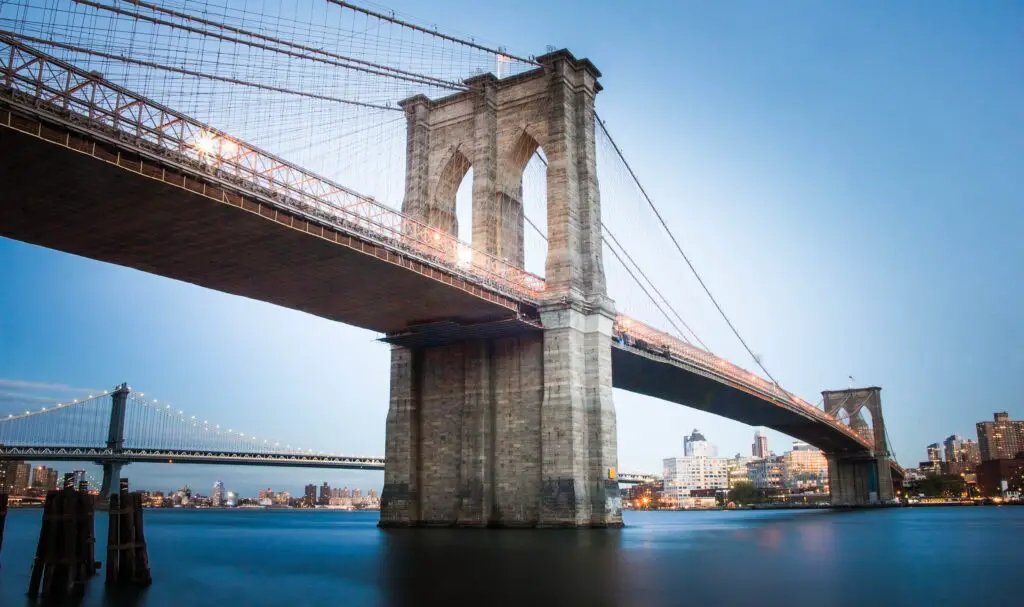Suspension bridge examples are some of the most iconic and impressive engineering feats in the world. Their ability to span large distances while withstanding intense winds and weather conditions has amazed people for centuries. From the towering Golden Gate Bridge in San Francisco to the historic Brooklyn Bridge in New York City, suspension bridges have become symbols of human ingenuity and perseverance. In this post, we’ll take a closer look at some of the most famous examples of suspension bridges around the globe, as well as explore different types of suspension bridge designs. So buckle up and get ready for an exciting journey through these magnificent structures.
The 1915 Çanakkale Bridge
The 1915 Çanakkale Bridge also known as the Gallipoli Bridge is a famous suspension bridge example recently constructed in Turkey. The bridge has a central span of 6,637 feet (2,023 m) and is the world’s longest suspension bridge today. The bridge is connecting the European and Asian sides of the Dardanelles Strait. The Çanakkale 1915 Bridge is named after the Battle of Gallipoli, which took place during World War I. The battle was fought between the Ottoman Empire and the Allies and resulted in a victory for the Allies.
The bridge was built to commemorate the 100th anniversary of the battle. Construction of the bridge began in March 2015 and was completed in 2022. The 1915 Çanakkale Bridge is one of the world’s longest examples of suspension bridges, surpassing the Akashi Kaikyō Bridge in Japan with a main span of 6,637 feet (2,023 m).

The Akashi Kaikyō Bridge
The Akashi Kaikyō Bridge is also one of the famous examples of suspension bridges in the world today, it crosses the Akashi Strait in Kobe, Japan. The bridge has a total length of almost 4 miles (12,831 m), making it the second-longest suspension bridge in the world today which was formerly the longest in the world before the completion of the 1915 Çanakkale Bridge in Turkey. It was completed in 1998 and has been open to traffic since then.
The Akashi Kaikyō Bridge is an engineering marvel. It was designed to withstand winds of up to 286 mph (460 km/h) and earthquakes up to magnitude 8.5 on the Richter scale. The main span of the bridge is 1,991m (6,532 ft) long. The total length of the bridge is just over 4 miles (12,831 m). The Akashi Kaikyō Bridge is one of the most popular tourist attractions in Kobe. The bridge has an observation deck that offers stunning views of the city and the surrounding area. Visitors can also take a boat ride under the bridge for a unique perspective.

The Brooklyn Bridge
The Brooklyn Bridge is one of the oldest suspension bridges in the United States, spanning across the East River to connect Manhattan and Brooklyn. Completed in 1883, it was originally designed by John A. Roebling, but after his death during construction, his son Washington Roebling took over as chief engineer.
The bridge’s Gothic-style stone towers and steel cables are iconic features that have made it a popular tourist destination for visitors from all around the world. The bridge spans a total length of 5,989 feet (1,825 meters), with its main span measuring 1,595 feet (486 meters). One interesting fact about this historic landmark is that it used to be illuminated by gas lamps when it first opened. This changed in 1912 when electric lights were installed instead.
Today, millions of people cross the Brooklyn Bridge each year on foot or by car. It has become an important symbol not only for New York City but also for America as a whole – representing strength and resilience through difficult times such as during times of war or terrorist attacks.

The Yangsigang Bridge
The Yangsigang Bridge is a suspension bridge in China. It is one of the largest suspension bridges in the world, with a main span of 1,700 meters (5,577 feet). The bridge was completed in 2019 and is currently the tallest bridge in China. The Yangsigang Bridge is a beautiful sight to behold, with its massive size and intricate design, is one of the longest examples of suspension bridges in China.
The Great Belt Bridge
One of the most iconic examples of suspension bridges in the world is the Great Belt Bridge, which spans the Great Belt strait between the Danish islands of Zealand and Funen. The bridge has a total length of nearly 6 km (3.7 mi), making it the longest suspension bridge in Europe.
The bridge was designed by Danish engineer Ole Smith, and it was completed in 1998, after 7 years of construction. The Great Belt Bridge is a marvel of engineering, with two massive pylons rising to a height of 204 m (669 ft). The bridge deck is suspended by cables that are attached to the pylons, creating a graceful and elegant design. The Great Belt Bridge is one of the busiest suspension bridges in Scandinavia, carrying over 25 million vehicles per year.
The Golden Gate Bridge
The Golden Gate Bridge is one of the examples of suspension bridges around the globe, located in San Francisco, California. It spans 4,200ft (1,280m) with a total height of 746 feet (227 m) across the Golden Gate Strait and connects San Francisco to Marin County. The bridge was completed in 1937 and was once considered the longest suspension bridge in the world.
The iconic reddish-orange color of the bridge was not its original color, but it has become an easily recognizable symbol of San Francisco since its construction. The bridge offers stunning views of both the city skyline and surrounding natural landscapes. The construction of this engineering marvel took four years to complete with over 10,000 workers involved in building it. Despite strong winds, tides, and earthquakes that hit the area from time to time, the Golden Gate Bridge remains one of America’s most famous landmarks.
Today, millions visit this architectural masterpiece each year either by foot or by vehicle for sightseeing or commuting purposes. It also serves as an important transportation link between San Francisco and other parts of Northern California making it an essential part of daily life for many people living in this region.

The Millennium Bridge
The Millennium Bridge is a suspension bridge example that spans the River Thames in London, England. It was opened to the public on June 10, 2000, and was designed by architects Foster and Partners with engineering firm Arup. The bridge connects Bankside on the south bank of the river to the City of London on the north. The design of this pedestrian-only bridge is unique in that it features a “sway” or “wobble” motion when many people walk across it at once. This unexpected movement caused some concern among pedestrians during its opening days but has since been stabilized with modifications made to its structure.
The Millennium Bridge provides stunning views of St Paul’s Cathedral and other landmarks along the river. At night, the lighting system illuminates both sides of this magnificent structure making for an impressive sightseeing experience. This suspension bridge also played an important role in popular culture as it was featured prominently in Harry Potter and the Half-Blood Prince where Death Eaters destroy it during their attack on London causing chaos and destruction.
The Millennium Bridge stands out as one of London’s most iconic bridges thanks to its modern design coupled with cutting-edge technology employed in construction. The bridge comprises three main sections 81 meters (266 feet), 144 meters (472 feet), and 108 meters (354 feet) (north-south) with a total structural length of about 325 meters (1,066 feet); and the aluminum deck of the bridge is 4 meters (13 feet) wide.
The Tower Bridge
The Tower Bridge is a world-famous example of a suspension bridge located in London, England. It was built in 1894 and has become an iconic landmark of the city. The bridge spans across the River Thames and connects two parts of London: Tower Hamlets and Southwark. One of the unique features of the Tower Bridge is the double-deck structure that allows both vehicles and pedestrians to cross it. The lower level was originally designed for horse-drawn carriages, while today it is used by cars, buses, and bicycles. The upper level is reserved for pedestrians who can enjoy stunning views over the river from the high-level walkway.
The bridge’s two massive towers are also impressive sights to behold. They are made out of granite and feature intricate Victorian Gothic-style details that add to their grandeur. Visitors can even climb up to one of the towers’ elevated walkways for an unforgettable panoramic view over London. Another interesting fact about this suspension bridge is that its main bascule (drawbridge) section can be raised to allow large ships to pass through underneath it. This rarely happens nowadays but when it does, it attracts crowds of spectators who come to witness this engineering marvel in action.
The Tower Bridge stands as a testament to human ingenuity and architectural excellence that has stood strong for more than a century as an important symbol of London’s history and culture. The bridge by the design is 240 m (800 feet) in length with two 65m ( 213 feet) bridge towers connected at the upper level by two horizontal walkways, with a central pair of bascules that opens to allow passage of ships.
The London Bridge
The London Bridge is also a famous suspension bridge example that crosses the River Thames in central London, England. It was opened in 1973 to replace an old stone-arched bridge that had stood there for over 600 years. The new bridge is made of concrete and steel, with two towers rising above the river. The design of the London Bridge is unique compared to other suspension bridges because it has a box girder deck rather than a traditional suspended roadway. This feature makes it more stable and allows for more traffic flow on the deck level.
One interesting fact about this iconic landmark is that it was sold to an American businessman named Robert P. McCulloch in 1968 who dismantled it and reconstructed it in Lake Havasu City, Arizona. Today, thousands of tourists visit London Bridge each year to take pictures and enjoy its breathtaking views of the city skyline. The famous Tower Bridge can also be seen from here as well as St Paul’s Cathedral which stands tall at one end whilst Shakespeare’s Globe Theatre lies just across on Bankside.
The London Bridge serves as a symbol of British engineering prowess and innovation while showcasing stunning architectural designs blended perfectly with modern technology – making our world better connected every day.
The Different Types of Suspension Bridges
Suspension bridges are one of the most popular and recognizable types of bridges in the world. They have been used to span long distances, connect cities, and provide safe passage for travelers over rivers, valleys, and other obstacles.
There are several different types of suspension bridges, each with unique characteristics that make them suited for specific applications. One type is the simple suspension bridge which consists of two main cables that support a deck between them. This type is typically used for shorter spans or pedestrian walkways.
Another type is the continuous truss bridge which has additional vertical supports built into its design to enhance stability. This makes it ideal for longer spans and heavier loads such as railway lines or highways.
A third type is a cable-stayed bridge which uses fewer cables than traditional suspension bridges but still provides excellent support due to its unique design. It features a central tower from which cables radiate outwards supporting the roadway on either side.
Each of these types has advantages and disadvantages that must be considered when designing a new suspension bridge. The choice depends on factors such as distance, load capacity, weather conditions, and budget constraints.
Understanding the different types of suspension bridges can help engineers choose appropriate designs based on specific needs ensuring safety while providing functional infrastructure.
Conclusion
Examples of suspension bridges are marvels of engineering that have connected people and places for centuries. From the iconic Brooklyn Bridge to the stunning Golden Gate Bridge, these structures represent some of humanity’s greatest achievements in building infrastructure.
The different types of suspension bridges offer unique features and benefits. Cable-stayed bridges are ideal for shorter spans while hybrid designs can withstand strong winds and heavy loads.
While they may seem daunting to construct, modern technology has made it easier than ever before to build these incredible feats of engineering. With careful planning and execution, suspension bridges will continue to play a crucial role in connecting people all over the world for generations to come.

